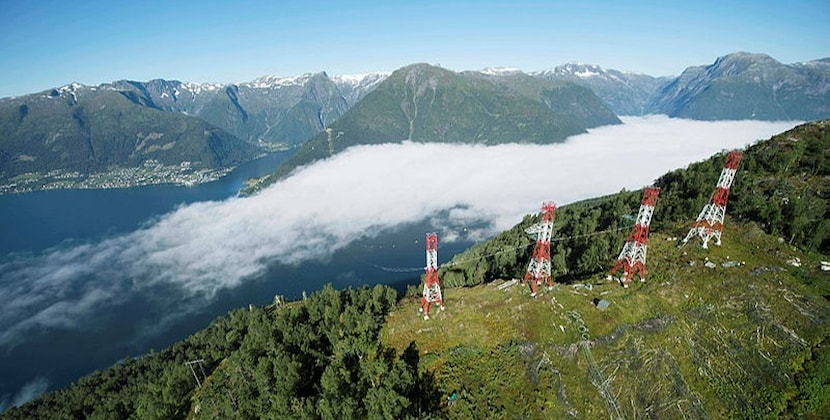The investment peak was reached in 2018
In 2018, Statnett built 225 kilometres of new power lines, upgraded 119 kilometres and put into operation 67 new switchgears at substations. Statnett also took over parts of the transmission grid from BKK effective January 1, 2018.
Among the largest development projects are three substations connected to the Ofoten – Balsfjord project, a new power line from Namsos to Hofstad, and the completed cable in the inner Oslofjord. In the project "Western Corridor", the voltage has been increased from 300 to 420 kV at several connections. The progress in this project is important to facilitate the upcoming interconnectors to Germany and the UK, which will be completed by 2021. In 2018, the first section of the cable to the UK was laid, and the cable to Germany was completed in the Norwegian sector. In addition, several power line and substation projects of varying sizes were completed or under construction in 2018. Within digitalisation, a new operating centre system and Elhub (February 2019) were successfully commissioned.
Challenging but stable operations
In 2018, grid operations remained sound but demanding due to large variations in precipitation and temperature through the year. There was also a need for a large number of disconnections related to development projects. Stable infrastructure and system operation nonetheless ensured good delivery reliability.
The future is still electric
Statnett’s report “Long-term market analysis – Nordics and Europe 2018–40” shows that society is transitioning to an increasingly electrified and more renewable power system more quickly than previously assumed. The measures that Statnett currently are implementing in the transmission grid, along with new system and market solutions, will ensure that the Norwegian transmission grid system is well equipped for an electric future. These measures will also facilitate handling of significant volumes of new renewable production and increased consumption without impacting security of supply.
The company experienced major interest for establishing new connections to the grid throughout 2018, in particular with regard to small-scale hydropower, wind power and data processing centres. In the second half of the year, the company implemented measures to reduce the backlog of inquiries regarding new connections.
HSE and efficiency
Statnett has a zero tolerance for accidents and has set the ambitious target of becoming a leader in HSE among European TSOs. The company systematically endeavours to prevent all accidents, personal injuries and damage to property and other tangible assets. In order to secure a better overview of the HSE status, in 2018 the company developed a set of measurement indicators. These will provide a better indication of potential incidents, from which the company can learn to avoid serious incidents in future.
By the end of the year, the company completed an extensive efficiency-improvement programme, in which it set a target of increasing efficiency by 15 per cent between 2013 and 2018. Statnett’s total impactable operating costs regarding weighted maintenance objects (WMOs) show a 17 per cent improvement from the 2013 budget to what was realised in 2018. Overall, it has been estimated that the programme will reduce the tariff basis by approximately NOK 5 billion in the period 2016–2025. This is around 5 per cent of the total tariff basis for the period, and equates to total tariff revenues for 2016.
Results
The Group posted an underlying profit after tax for 2018 of NOK 1,934 million (NOK 1,304 million in 2017). The consolidated accounting profit after tax came in at NOK 2,213 million (NOK 813 million).
Differences between these two results, which are known as higher or lower revenue, must be balanced through changes in tariffs, meaning that over time Statnett’s accounting revenues will equate to regulated permitted income.
The Group invested NOK 12,377 million (NOK 9,235 million). This is the highest investment level for Statnett in a historic perspective. Statnett is expecting a gradually reduced level of investment in the years ahead.

